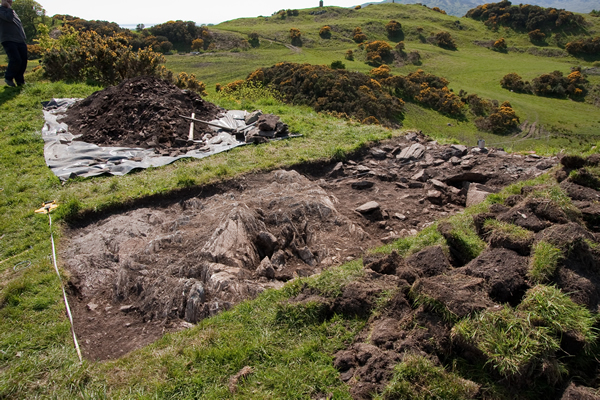
The recent archaeological excavation of Trusty's Hillfort has discovered striking new evidence for the lost Dark Age Kingdom of Rheged.
Trusty's Hillfort, near Gatehouse of Fleet in Dumfries and Galloway, is best known for the Pictish Symbols carved into a natural rock outcrop at the fort's entrance. However, in recent years, many historians have begun to doubt whether these carvings were genuine, some even suggesting that the carvings are forgeries. The Galloway Picts Project, led by the Dumfriesshire and Galloway Natural History and Antiquarian Society and funded in part by the Heritage Lottery Fund, sought to find out why there are Pictish Carvings here, so far from the Pictish heartlands in the north-east of Scotland, and if the carvings are indeed genuine.
Under the direction of two members of the Society, local volunteers and professional archaeologists from GUARD Archaeology Ltd have over the last two weeks recovered plentiful archaeological evidence for when the site was occupied, how it was occupied and indeed the status of the people who occupied this hillfort. An abundance of domestic rubbish, including animal bones, a rotary quern, tools and a spindle whorl demonstrate that Trusty's Hill was once the home of a small community. There was also clear evidence, in the form of crucibles, a clay mould and iron slag, that metalworking and the production of high status jewellery was being carried out in part of the site. But the clincher for the Galloway Picts Team was the discovery of high status jewellery itself and even rarer pottery sherds from France. The pottery sherd not only dates to the seventh century AD, exactly the right time when Pictish Symbols were being carved in Scotland, but are so rare from this period that only people of the highest status - kings, princes, lords and bishops - acquired this pottery.
While much specialist analyses needs to be undertaken over the next few months, the team are confident that they have discovered not only that the Pictish Carvings are genuine but that this was probably a royal stronghold of the lost Dark Age Kingdom of Rheged. The two only other sites outside Pictland where Pictish Carvings are found are the capitals of other Dark Age Kingdoms: Dunadd, the capital of the early Scots Kingdom of Dalriada, covering what is now Argyll and Bute; and Edinburgh Castle Rock, once called Din Eidyn, the capital of the Kingdom of the Gododdin, which covered South-east Scotland. The finds from the recent dig at Trusty's Hill shows that the Britons here were of the same social status as the people who ruled from these centres. Excitingly, the new evidence shows that like other royal sites, the residents of Trusty's Hill were able to produce fine metalwork which was used as gifts to bind people to their kings and lords in an society without money. The layout of Trusty's Hillfort, with an upper citadel where a great hall may have stood, and lower precincts where activities like metalworking may have been undertaken, is exactly how royal Dark Age Capitals were arranged.
The mysterious kingdom of Rheged, remembered only in the poetry of Taliesin composed in the sixth and seventh centuries AD, has long been thought to have originated somewhere in Dumfries and Galloway and Cumbria. The excavation has now discovered the archaeological evidence to show that Trusty's Hill is the same type of site as other Dark Age Royal Capitals and proves, along with the evidence from Whithorn and another fort, Mote of Mark, near Rockcliffe, that Galloway was central to Rheged in the Dark Ages and had far flung contacts and trade with Gaul and the Eastern Roman Empire. Given that this is not found elsewhere in Dumfriesshire or Cumbria, Galloway is now looking to be the place where kings like Urien of Rheged, and his son Owain ap Urien, held sway.
But the Galloway Picts project isn't finished! A team of stone conservators from Historic Scotland are undertaking a laser scan of the Pictish Symbols at Trusty's Hill this week. The Galloway Picts team hope that this will allow a specialist to examine in detail how the Pictish Carvings were made and also translate an ogham inscription - a form of writing developed in Ireland in the first centuries AD and brought over to Scotland by the Scots - which has been noted along the edge of the carved stone. This work may reveal more about why the cultures of three Dark Age groups, the Britons, the Picts and the Scots came together at Trusty's Hillfort.